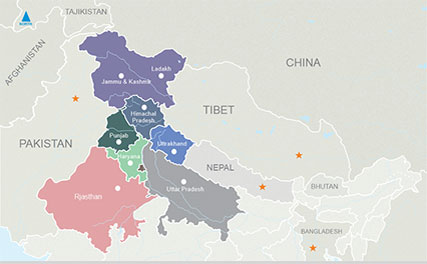
Kailash Manasarovar Aerial Darshan at Just @ Rs 35,000 Reserve Your Seat Now! Click Here
Visit the ancient town of Chamba to get enthralled by the grandeur of Himalayas. Experience nature’s beauty in full form in this enticing little town! The opulent heritage and rich culture of the region makes it such an interesting experience to hear stories about the bygone era. Visiting temples and palaces with intricate architecture gives a glimpse of the fine craftsmanship.
You can also enjoy shopping in local markets or go for excursions, treks, and nature walks. The refreshing mountain breeze, verdant green valleys, and snow covered mountains will be such a pleasant change from the chaos of cities. Plan a trip with your friends and family to bring back happy memories in abundance.

100,000
Chamba Fort, Chamba Palace, Chamba Museum, Chamba Valley
26°C to 32°C
24°C to 30°C
18°C to 24°C
Tucked in the valley of River Ravi, Chamba is an enticing old town with beautiful temples, a worthy museum and busy markets. Founded in AD 920 by Raja Sahil Varman, Chamba became his new capital as he moved from Bharmour. Interestingly, historical records date Chamba to 2nd Century BC wherein this region belonged to the Kolian tribes. The Maru dynasty ruled Chamba for a good long period with Raja Maru from 500 AD. The place was earlier ruled from Bharmour, the old capital which is around 65 km from Chamba town. Around 67 Kings or Rajas have ruled over Chamba post Raju Maru’s era till 1948, until when it got merged with Indian Union. Although Chamba kingdom was under British control since 1846, until India’s independence, the kings maintained their rule in coordination with the British governance.
Tourists generally make this place a stop-over while visiting the nearby hill towns like Jhumhar, Sarol, Saho etc., which are comparatively less commercialized and less travelled. Nevertheless, Chamba has a number of Hindu temples, historical places and a good museum to visit. The Lakshmi Narayan Temple Complex, Chamunda Devi Temple, Bajreshwari Devi Temple, Sui Mata Shrine, Champavati Temple and Bansi Gopal Temple are the famous ones. The Bhuri Singh Museum has preserved the past with grace for tourists to know more about the place & its history.
When here, do visit Rang Mahal and the Chamba Palace. Rang Mahal in Surara Mohalla is an impressive remain of the past, with sky-high fort-like walls. Apart from being the residence of the then ruling family it was used as the royal granary and treasury. The Chamba Palace, also known as Akhand Chandi Palace and is an eminent building of the past looking over the famous Chaugan of Chamba. Made during Raja Umed Singh's era, somewhere in-between 1748-1764 this royal residence spreads across a huge area. It has artistically carved wooden doors, handrails and window frames that elaborate the beauty of bygone days. I intricate wood and glass work and the colonial architecture makes this place interesting.
Chamba is also a famous destination for culture & festival holidayers. Two popular fairs or melas, even called as Jatra in local dialect are held here, namely the "Suhi Mata Mela" and the "Minjar Mela". The annual Minjar Fair is held sometime in July and August at the central Chaugan of Chamba. It was held from July 26-August 2, in 2015. During this fair, all the Gods and Goddesses from the different temples of the Chamba are brought here in processions to meet the prime deity, Raghuvira. These fairs are the best time to experience the local culture, music, dance and traditions.
Put us on work to plan your next travel. Send your details to our experts now to get a free travel plan with quote